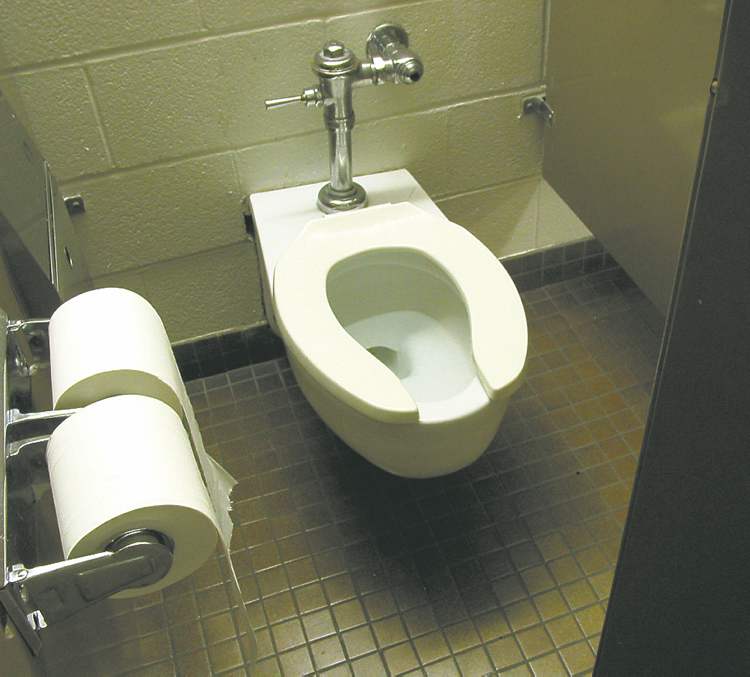On which side of toilet-seat shape debate do you sit?
Advertisement
Read this article for free:
or
Already have an account? Log in here »
To continue reading, please subscribe:
Monthly Digital Subscription
$1 per week for 24 weeks*
- Enjoy unlimited reading on winnipegfreepress.com
- Read the E-Edition, our digital replica newspaper
- Access News Break, our award-winning app
- Play interactive puzzles
*Billed as $4.00 plus GST every four weeks. After 24 weeks, price increases to the regular rate of $19.00 plus GST every four weeks. Offer available to new and qualified returning subscribers only. Cancel any time.
Monthly Digital Subscription
$4.75/week*
- Enjoy unlimited reading on winnipegfreepress.com
- Read the E-Edition, our digital replica newspaper
- Access News Break, our award-winning app
- Play interactive puzzles
*Billed as $19 plus GST every four weeks. Cancel any time.
To continue reading, please subscribe:
Add Free Press access to your Brandon Sun subscription for only an additional
$1 for the first 4 weeks*
*Your next subscription payment will increase by $1.00 and you will be charged $16.99 plus GST for four weeks. After four weeks, your payment will increase to $23.99 plus GST every four weeks.
Read unlimited articles for free today:
or
Already have an account? Log in here »
Hey there, time traveller!
This article was published 29/04/2013 (4555 days ago), so information in it may no longer be current.
Our efforts to dispel the mysteries of the modern visual landscape come to a head this week.
What are the chances you’re reading this in the bathroom? Pretty good, apparently. Where else in this hectic world are you going to find the peace and quiet to read, plan your social life or check if you’re the first person to consider pitching a show called The Real Housewives of King’s Landing?
You’re especially likely to be in the bathroom if you’re an Android user, according to a 2012 study, which found that 87 per cent of such people regularly engage in what’s been called “bogging,” compared with a mere 77 per cent of iPhone users. Half of all water-damaged phones are damaged by, um, eau de toilette. I haven’t seen any data on what percentage of Americans clean their phones after bathroom usage, but a recent study concluded that 16 per cent of our phones “have poop on them.”

Lovely. But where were we? That’s right: on the can. So, look down. Is the toilet seat U-shaped, like a horseshoe, with a gap in front? Or is it a continuous, O-shaped ring?
If you’re in a public restroom, the seat is probably U-shaped. If you’re enthroned at home, you’re probably on an O-shaped seat. As a reader — willing to be identified only as “Laurie from Edmonton” and reluctant to comment on the record about where she reads Slate — asked in a recent email, what’s the deal with the U-shaped ones?
Well, Laurie from Edmonton, there are many unsatisfying theories out there. Perhaps men are less careful in public toilets, “away from the restraining influence of their families,” some have said. The U-shaped seat might stay cleaner if the seat isn’t raised. Maybe guys don’t want their business touching the seat away from home? But women’s restrooms have the same seats — and wouldn’t the same reluctance apply at home, albeit to a lesser degree? Perhaps people are (unnecessarily) afraid of catching STDs from public toilet seats. Or maybe U-shaped seats are somehow easier to clean. And then there’s the theory put forward by Pasha Malla at the online magazine Morning News: U-shaped seats use less material and so are cheaper to make and to clean.
Even Wikipedia is sending mixed signals. In the online encyclopedia’s tome on toilet seats, the subsection on open front toilet seats also mulls various theories, e.g., that the U-shaped seat is ergonomically better. (How exactly? It’s not clear, nor is there any explanation why the same logic wouldn’t apply to home seats.) The next section states point blank that the reason for the U-shaped seat is to reduce “spatter” and make cleaning easier.
None of these theories is quite right. The original purpose for the U-shaped seat, according to Lynne Simnick, senior director of code development at IAPMO — the International Association of Plumbing and Mechanical Officials — was to aid women. Simnick explains that the open seat was designed to allow women “to wipe the perineal area after using the water closet” without contacting a seat that might be unhygienic.
Simnick notes that while women were the originally intended beneficiaries of the U-shaped seat requirement, men also benefit. The design “eliminates an area that could be contaminated with urine” and also “eliminates the user’s genital contact with the seat.”
There is a sensible exception to the Uniform Plumbing Code requirement. If a public restroom has an automatic toilet-seat cover dispenser, the seat doesn’t need to be U-shaped.
— Slate

